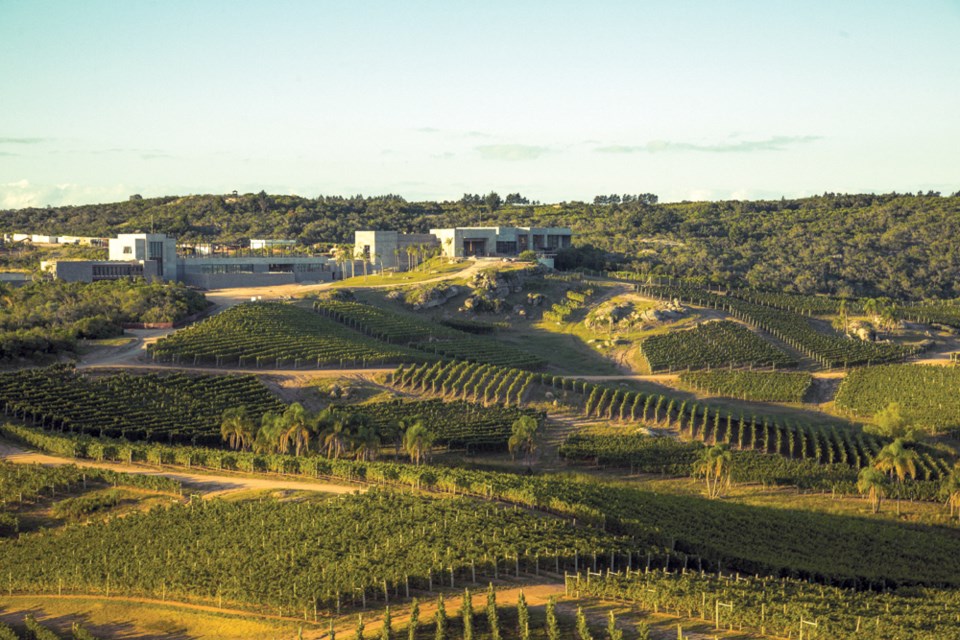Ask someone to name a New World wine producer and they’ll probably point to California, Chile, Australia or Argentina.
It’s unlikely that Uruguay will be in the mix. However, a few weeks ago, Uruguay’s new star, Bodega Garzon came to town to present its recently revamped portfolio.
While it may be under the radar, Uruguay is the fourth largest South American producer after Chile, Argentina and Brazil. The industry traces its beginnings back more than 250 years. But things started to look up when an emigré from Madiran (in present day southwest France) established Tannat in the 1870s.
Tannat, well named, can be as rustic and as tannic as it sounds. But in the right place – and in the right hands – it makes an impressive, smooth, well-structured red.
Uruguay’s wine regions are situated on latitudes similar to wine regions in The Cape, Hunter Valley, Margaret River and elsewhere.
However, while most of Uruguay’s plantings are located west of and around Montevideo on the north shore of the River Plate, expansive Bodega Garzon is well to the east, beyond the resort of Punta del Este (East Point), 18 kilometres inland from the Atlantic.
The scale of the vineyards is immense, some 230 hectares broken down into approximately 1,000 individual parcels, each one harvested and vinified separately.
The entire massive development is the brainchild of Argentinian magnate Alejandro P. Bulgheroni. However, heading up the winemaking team is celebrated “flying winemaker” Alberto Antonini, who is understandably excited about this immense, complex and truly unique project.
“As a producer, Uruguay is a very inspiring place,” says Antonini. “But you have to have a lot of imagination.”
He suggests Uruguay’s main region is not the best wine area due to its deep, fertile soils that don’t work well for the grapes, and don’t properly ripen the tannins.
“There in the top soils the vines are eating Big Macs. If you want to eat better you go deeper,” quips Antonini.
By contrast, just inland but almost right on the Atlantic coast, Bodega Garzon benefits from any number of elements, ranging from mineral soils to the constant breezes that dry after frequent rain.
The winemaker says that while it made sense to plant Tannat and Albarino, they also wanted to see how other varieties – such as Cabernet Franc – would perform. The winemaker is also steering the LEED-certified winery along similar lines to other clients with whom he consults, such as Okanagan Crush Pad.
Several impressive wines from this tasting of current vintages included Viognier, Single Vineyard Albarino, Pinot Noir Rosé, Marselan, Cabernet Franc, Petit Verdot and Single Vineyard Tannat. Many or all of these wines should be in the market in the coming months (full notes soon at hiredbelly.com).
• • •
Looming large on the horizon, the California Wine Fair lands in Vancouver on April 24. The fair, which features more than 400 wines from the Golden State, is a must for legions of California wine lovers, so best to grab those tix now. At VCC East, 7-9:30 p.m., this mega-tasting will benefit the Arts Club Theatre also feature a silent auction and plenty more. Tickets: $80, from 604-687-1644 or at artsclub.com.
• • •
Conundrum White 2014 (California): The 25th anniversary salute to Chuck Wagner’s original Big Idea stays true to form with appealing honey and peach plus lifted tropical notes before a creamy palate with melon and pineapple, wrapped in a well-textured mouthfeel and lingering finish (90 points).
Tim Pawsey writes about wine for numerous publications and online as the Hired Belly at hiredbelly.com. Contact: info@hiredbelly.com.



